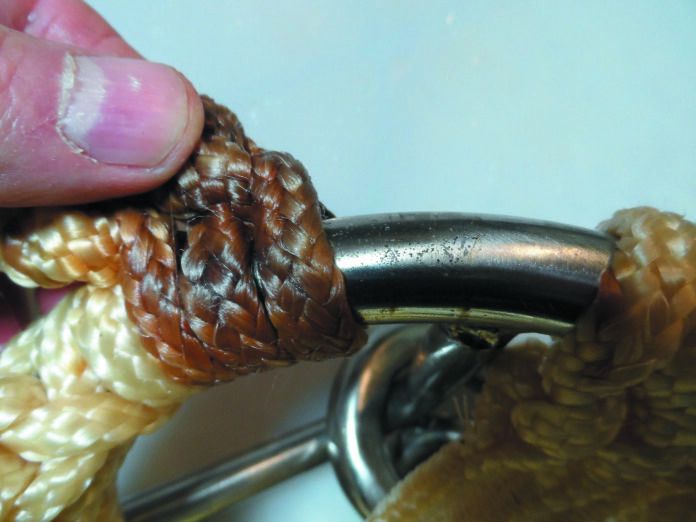Often stainless steel hardware on our sails will begin to rust under the cloth webbing, not only staining the fabric and webbing, but inviting crevice corrosion.
The cause is a lack of oxygen under that tightly fitted bit of webbing, and the fabric holds moisture and salt that breeds corrosion. If left alone, the stainless could weaken, especially near welds.
Nylon in spinnakers is damaged by prolonged exposure to pH less than 3 (the minimum pH used in dying operations). Polyester in working sails, however, can better tolerate acid, so passivation with standard citric acid solutions is fine (see “Passivating Stainless,” PS July 2020). But what if there’s some nylon—in the thread, for example?
Citric acid and products like Spotless Stainless, and CitriSurf 77 are too acidic for the prolonged soaking that passivating stainless under webbing and rope might require, but there are passivating solutions formulated for ferritic and martensitic steel (common in chef’s knives) that have a milder pH.
CitriSurf 2250 is buffered to a pH of 3.0 to prevent staining more sensitive 400 series grades of stainless steel. We have used this for knives and on sail clew rings and can recommend it. CitriSurf 2450, formulated for very low chrome stainless, is buffered to a pH of 4.3. We have never tried it, but we are confident the action would be slow but safe.
Rust removal and passivation time is greatly reduced if brushed with a stainless steel brush (metals) or bristle brush (fabrics) to loosen heavier accumulations.
What about lower concentrations? We soaked some samples of nylon webbing in 1 percent citric acid overnight and then pull-tested them. There was no measurable loss in strength, although the rust removal action was slower. A few hours would have been enough.
A better alternative, for the DIY chemist, is to create a pH 3.0 buffer by adding about one part sodium citrate for every four parts citric acid. Use a 5 percent citric acid passivating concentration, and slowly add sodium citrate (available online) while checking the pH. The more sodium citrate, the higher the pH. This buffered citric/citrate solution will mimic the more gentle action of CitriSurf 2250. (A small amount of baking soda—pH 8.3—in water can be used instead of sodium citrate, but monitor the pH.)
To passivate, simply soak the affected hardware and cloth in the solution for several hours. Though initially fused in place by corrosion and shrinkage, the webbing often loosens enough that it can be shifted aside to wire-brush. Even just sliding the webbing around will help loosen corrosion and speed the process.
At the end of a few hours, rinse thoroughly, multiple times. Some visible rust will remain in the fabric. Some can be scrubbed out with a toothbrush and detergent, and the rest is best left harmlessly in place.
For those with traditional sails and bronze rings, citric acid is also effective on bronze. Stellar Solutions recommends CitriSurf 77, but lemon juice (pH 3) is a traditional bronze cleaner, and the buffered solutions suggested above are also effective.
Do not use oxalic, acetic, lactic or phosphoric acid for passivating stainless attached to sails. The low pH of some could damage any nylon in the sail and they will not passivate the underlying stainless, which was sort of the main point. If you are just trying to loosen up an aluminum zipper, citric and lactic acid are effective and non-corrosive towards aluminum.










































Thanks for sharing! A deck takes a beating over time. As a result, it will have an unappealing appearance. Black streaks and yellowish stains are also possible. A boat deck cleaner can make it shine and look new again.